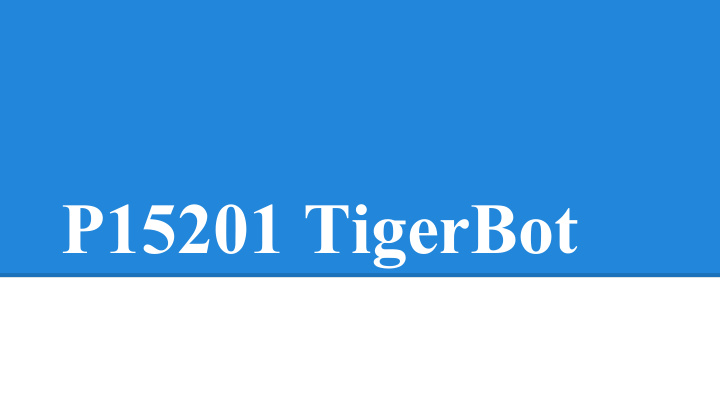



P15201 TigerBot
Introduction Chris Crippen - Electrical Engineer - Team Manager Matthew Mares - Mechanical Engineer David Exton - Mechanical Engineer Wunna Kyaw - Mechanical Engineer Benjamin Haag - Electrical Engineer Jordan Skiff - Electrical Engineer Vincent Pan - Electrical Engineer Matt Warner - Computer Engineer Vasu Gupta - Computer Engineer
Agenda 1. Project Summary 2. Project Goals and Key Deliverables 3. Stakeholders 4. Use Case Scenarios 5. Customer Requirements 6. Engineering Requirements 7. House of Quality 8. Constraints 9. Questions
Project History This senior design project is the fifth project of the series of projects planned, called TIGERBOT, for developing humanoid robots at RIT. The ultimate goal of the project series is to develop a robotic tour guide for RIT that could be used to recruit prospective students through demonstration.
What is a tigerbot? Tigerbot #1 Tigerbot #3 Tigerbot #4 Our Tigerbot
Problem Definition The goal of this project is to take the TigerBot design to the next level—a full scale platform that will control the locomotion of the TigerBot while providing the base for future components, sensors or aspects of intelligence. The full scale platform must be autonomous, untethered, and able to walk straight and turn, avoid obstacles, and recover from a forward or backward fall. This senior design team’s focus will be on the locomotion of the platform.
Project Goals & Deliverables 1. Working Prototype a. A walking, turning and balancing humanoid 2. Autonomous 3. Resistant to fall 4. Able to get up from any fall 5. Some human interaction via voice
Stakeholders 1. Dr. Sahin 2. MSD Team 3. RIT 4. Visitors to RIT
Use Case Scenarios
Customer Requirements
Engineering Requirements
House of Quality
Constraints 1. TigerBot must be greater than 5 ft. tall and less than 5 ft. 5 inches 2. Center of Gravity needs to be lower than the waist 3. Untethered operation 4. The ability to localize its position within the building using external or internal sensors 5. Components must be available on the market 6. A Microcontroller which will handle the motion control of the robot with an embedded OS (Linux ROS) pre-loaded into RAM (>2GB) and expose interfaces to I2C, SPI, and USB. 7. Accelerometers and Gyroscopes are required to sense external forces and TigerBot orientation
Questions?
Recommend
More recommend